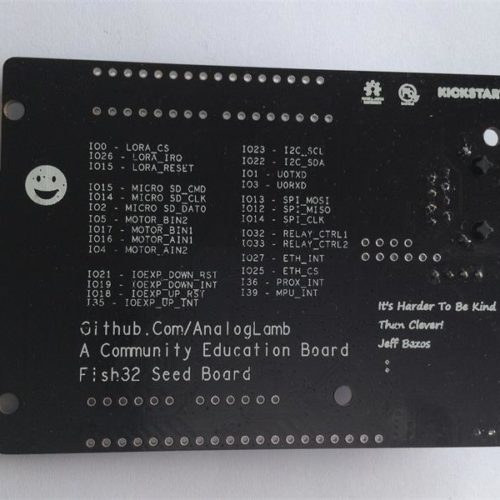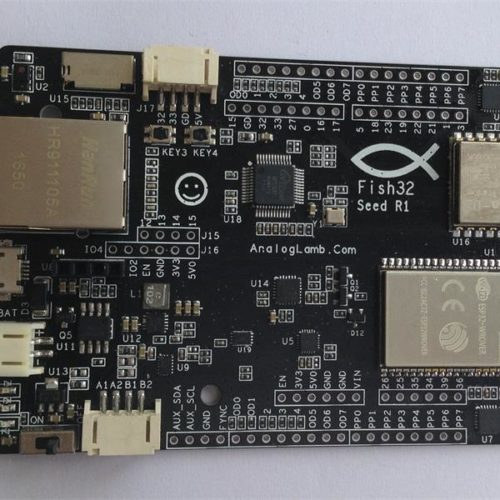Sometimes I feel the word “Education” is sometimes thrown around for marketing purpose, and AnalogLamb Fish32 Seed board for “ESP32 Community Education Board” feels that way to me as so far, I could not see any tutorials or other teaching/ learning resources for the board.
Having said that I can see why it could be potentially used for education: the sheer number of features, sensors, and connectivity options should allow students to learn to program my different components around ESP32. It’s just at this stage it may not be such an easy platform to learn on.
Fish32 Seed board specifications:
- Supported ESP32 Modules – ESP32-WROVER, ALB32-WROVER, ESP32-WROOM-32
- Connectivity
- 802.11 b/g/n WiFi and Bluetooth 4.2 via ESP32
- 10/100M Ethernet (RJ45) via WIZnet W5500 chip with support for up to 8 independent sockets
- LoRa via SX1278 chip (433 MHz)
- Sensors
- NXP MPU-9250 with 3-axis MEMS gyroscope, 3-axis MEMS accelerometer, 3-axis MEMS magnetometer
- Broadcom APDS-9960 digital proximity sensor, ambient light sensor, RGB color sensor, and gesture Sensor
- Storage – SD card socket
- Hardware Security – ATECC508A CryptoAuthentication chip
- Expansion I/Os
- Arduino headers (unpopulated)
- 8x Open-Drain I/O ports, 8x Push-Pull I/O ports via SN7325 2-wire serial-interfaced chip
- Motor Control via DRV8835 dual-H-bridge motor driver supporting up to 2x DC motors or 1x stepper motor up to 1.5A current per H-Bridge
- Misc – CP2104 for debugging, buttons, relay
 We learned a little more about the board on the back. First, it’s said to be open source hardware, and could be launched in Kickstarter. If we go to AnalogLamb github though, there’s no info about Fish32 Seed Board yet, and activity is rather limited with only two contributions in the last year.
We learned a little more about the board on the back. First, it’s said to be open source hardware, and could be launched in Kickstarter. If we go to AnalogLamb github though, there’s no info about Fish32 Seed Board yet, and activity is rather limited with only two contributions in the last year.
AnalogLamb is taking pre-orders for $49.99 plus shipping with availability planned for September 15, 2018.

Jean-Luc started CNX Software in 2010 as a part-time endeavor, before quitting his job as a software engineering manager, and starting to write daily news, and reviews full time later in 2011.
Support CNX Software! Donate via cryptocurrencies, become a Patron on Patreon, or purchase goods on Amazon or Aliexpress






The ESP32 chip has a native Ethernet interface, only the PHY has to be added externally.
So why add a W5500?
This means that none of the ESP32 Ethernet code will work, but instead you have to add the code for the W5500, which is available for Arduino, but not for the native SDK.
And why did they add a bunch of sensors and interfaces, but no CAN transceiver? The ESP32 also has a native CAN bus.
And PoE isn’t even an option.
I am guessing that the wider Arduino SDK toolchain is the source of education material and the board configuration is built the same Arduino SDK specification.
That’s likely, because there are a lot of examples for Ethernet over W5500, but not many for native ESP32 Ethernet.
But the same is true for WiFi over ESP32 or ESP8266. Would they have followed the same path there, it would’ve made more sense to use an ATMEGA or SAMD as a main processor, and an ESP8266 as a (serial) WiFi adapter.
Also much more examples readily available for this configuration.